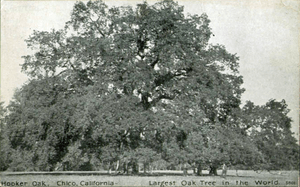Hooker Oak facts for kids
Quick facts for kids Hooker Oak |
|
|---|---|

Postcard featuring the Hooker Oak circa 1910
|
|
| Location | Bidwell Park, Chico, California |
| Reference no. | 313 |
| Lua error in Module:Location_map at line 420: attempt to index field 'wikibase' (a nil value). | |
The Hooker Oak was a truly giant oak tree in Chico, California. It was a special type of oak called a valley oak (Quercus lobata). In 1887, a local plant lover named Annie Bidwell gave the tree its name. She named it after a famous English botanist (a plant scientist) named Sir Joseph Dalton Hooker. He was in charge of the Royal Botanical Gardens in London. This amazing tree even appeared in the 1938 movie The Adventures of Robin Hood, starring Errol Flynn. Sadly, the tree fell in 1977. Parts of its wood were later used by local artists and craftspeople.
Contents
Discovering the Giant Oak
When Sir Joseph Dalton Hooker first saw the tree in 1872, he said it was the biggest valley oak in the world. Since then, other valley oaks of similar size have been found.
In 1921, the Hooker Oak was over 110 ft (34 m) tall. A newspaper, The Sacramento Bee, reported in 1958 that about 7,885 people could stand under its huge leafy top. Imagine that many people fitting under one tree!
The End of a Legend
The Hooker Oak finally fell on May 1, 1977. At that time, it was nearly 100 feet (30 m) tall. About eight feet (2.4 m) from the ground, its trunk was 29 feet (8.8 m) around. The longest branch stretched 111 feet (34 m) from the trunk to its tip. The total spread of its outer branches was nearly five hundred feet (150 m).
People thought the tree was about a thousand years old. But when it fell, they discovered it was actually two trees. Each tree was about 325 years old. They had grown together long ago to look like one giant tree.
What Happened to the Wood?
For three years after the tree fell, it lay on the ground. City leaders in Chico had to decide what to do with it. In the spring of 1980, the city hired a company called Cal Oak Lumber Company. Their job was to remove and save the good parts of the tree's wood. They were allowed to keep some of the wood as payment.
After cutting the oak into lumber, Cal Oak arranged for it to be dried. This happened at the University of California, Berkeley's Forest Products Laboratory.
Cal Oak then started a special program. They worked with local artists and training centers for people with disabilities. Together, they made a limited number of beautiful items from the wood. Many of these items were given to important places. These included the Royal Botanical Gardens in London, the Butte County Historical Society, and Bidwell Mansion State Historic Park.
The Royal Botanical Gardens also received acorns from the original tree in 1981. They planted them in their gardens. The Chico Fire Chief, Elmer Brouillard, even made gavels and plaques from the wood for the Chico City Council.
Special Wood Characteristics
The people at Cal Oak and the University of California Berkeley Forestry Lab were very interested in the tree's wood. It turned out to be as amazing as the tree itself.
To support its huge top, the tree grew a lot of extra strong wood on the upper side of its branches and stems. This special wood is called "tension wood." It gave the tree an incredibly high density. It was about 50% heavier than wood from other oak trees nearby. This, along with other special features, gave the wood its unique look and strength. It also likely helped the tree live for so long.


